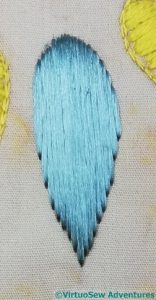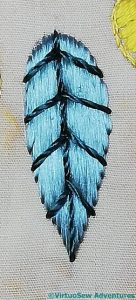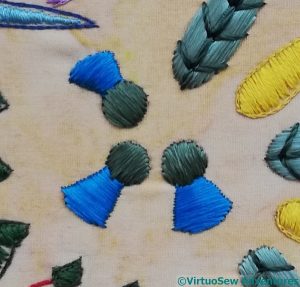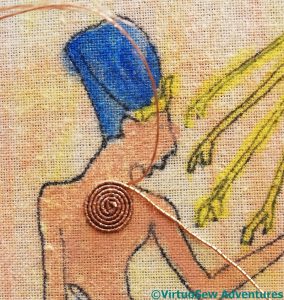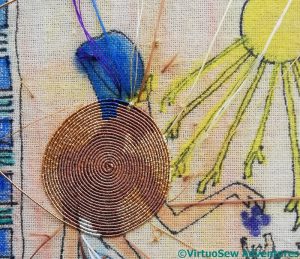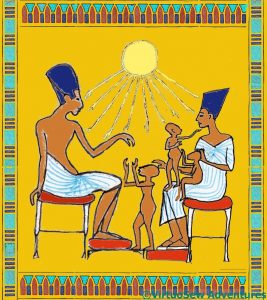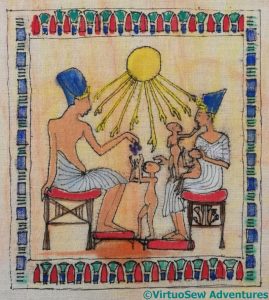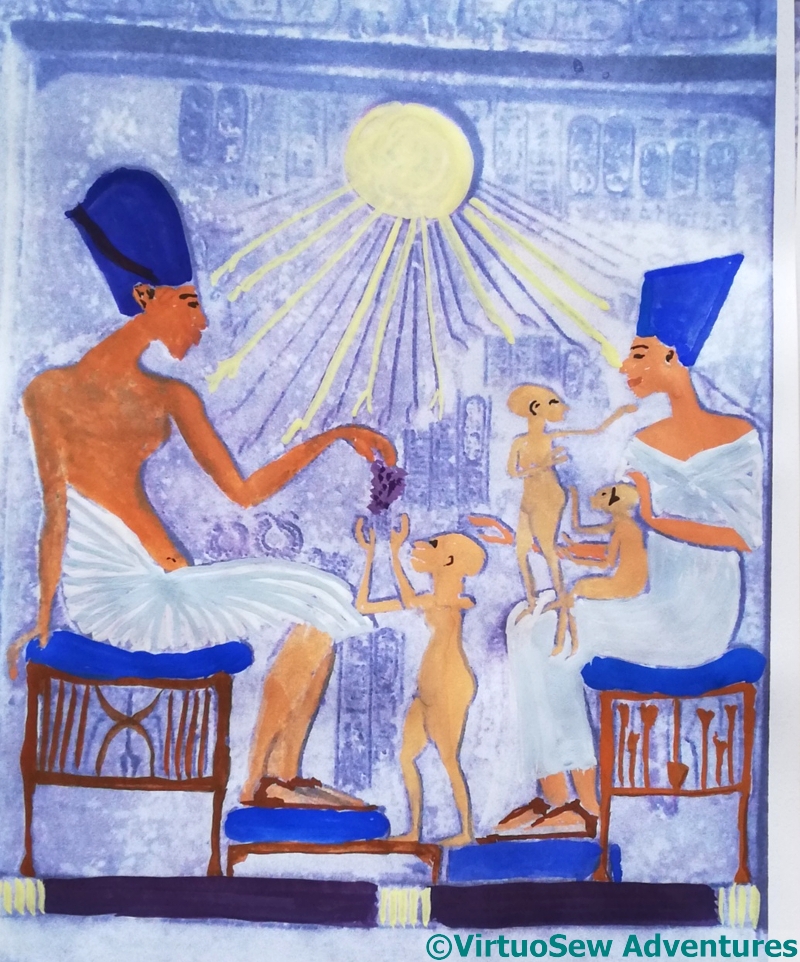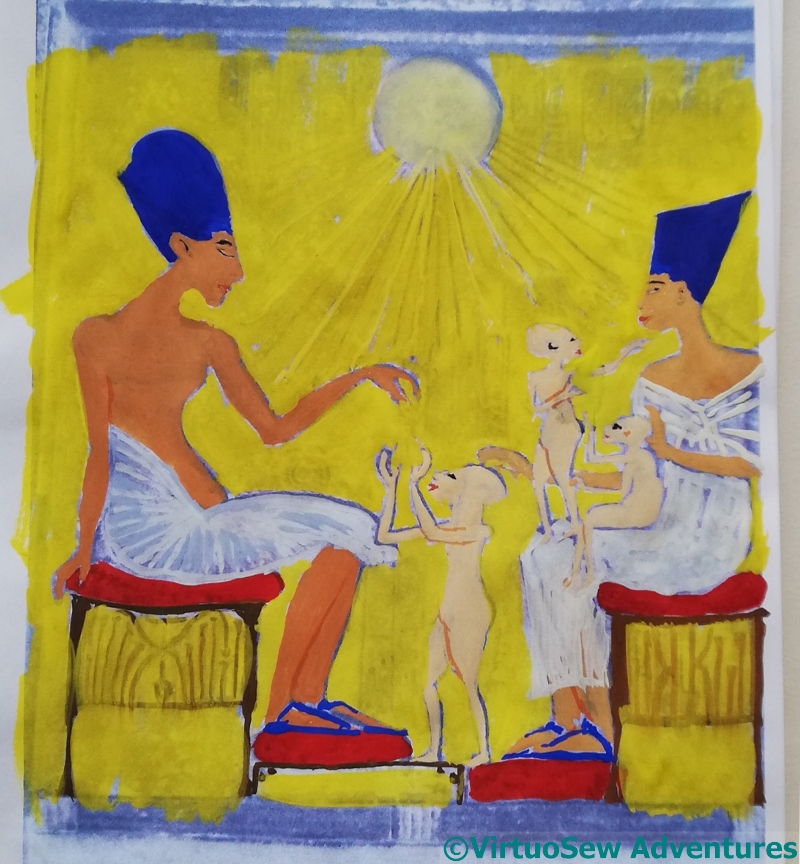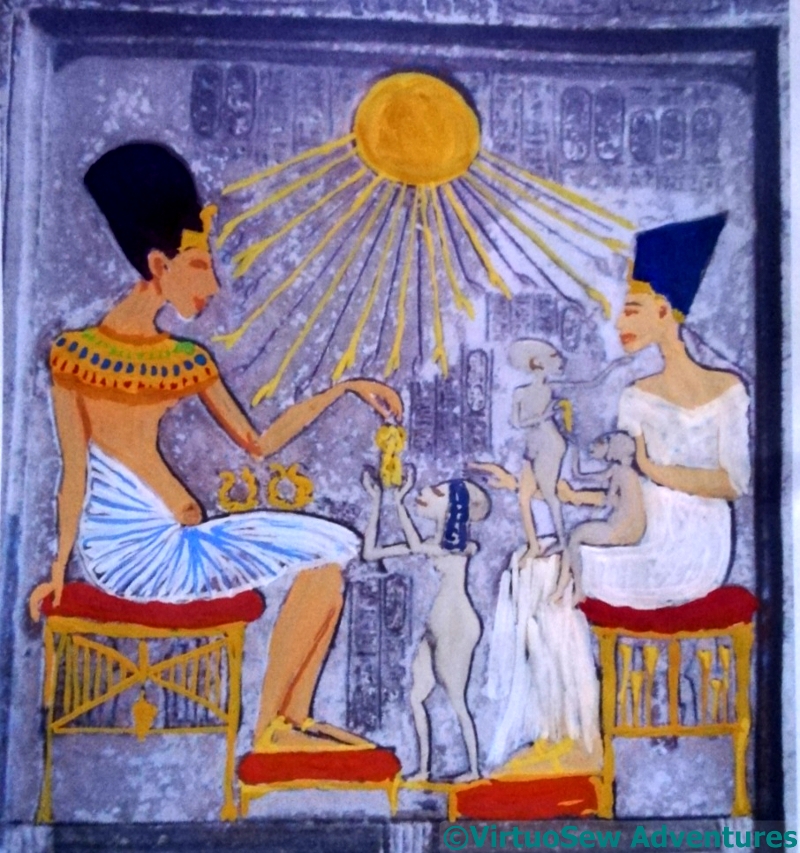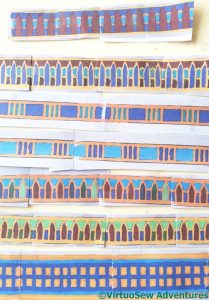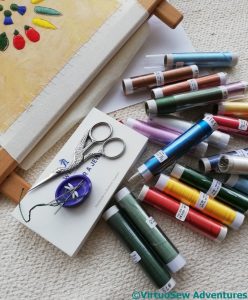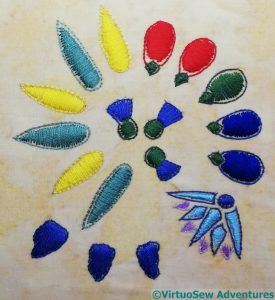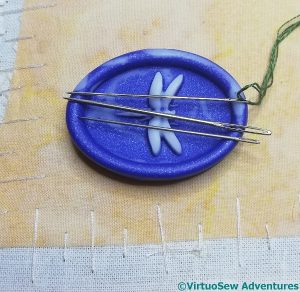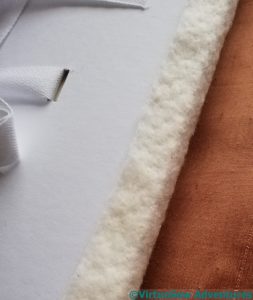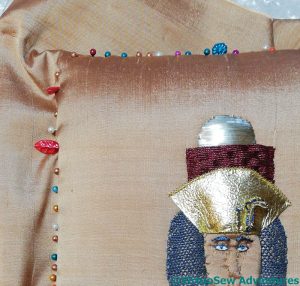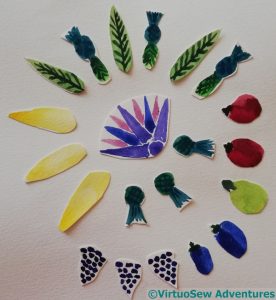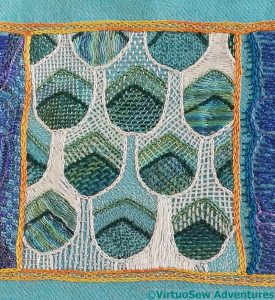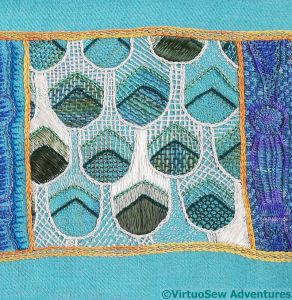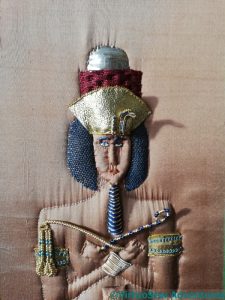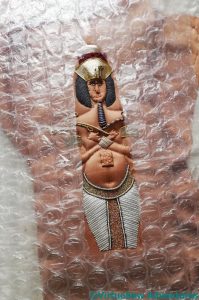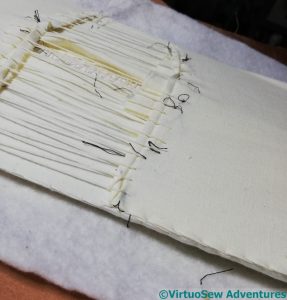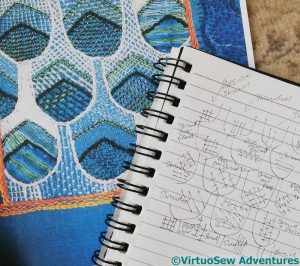Category: Dreams of Amarna
More progress on the Faience Necklace
There is another episode of SlowTV Stitchery up – Episode Three. I’ve also done two shorts, one introducing the Dreams of Amarna project as a whole, and one, for the Amarna Family Group in particular. Please ask me any questions you like, either here in the comments, or by email, and I will try to answer them in one of the later episodes. It might take a while, though, because people have been stacking up questions like cordwood!
Now, back to the Faience Necklace, which I’ve neglected… The first elements I decided to do were among the simplest – the three palm leaves.
First layer, as I said, is plain satin stitch in flat silk. Satin stitch makes me nervous, but flat silk spreads and blends together, which makes it about as easy as it can be for me.
The next stage was to hand-twist a two ply perlé -type thread to stitch the veins, using straight stitches. In this case, I used two of the strands of filaments for each ply, and I tried not to over-twist the final assembly.
That made for a lovely thread, with a bit of body and “lift”. A pleasure to use!
If I have correctly interpreted the description that Mary Chubb typed out on that first afternoon, when she came back from her epiphany in the cellar, this shape was described as a cornflower, so I went with my brightest blue, and the middle greyish-green shade for the calyx.
You will notice that the stitching on the two sections is at right angles one to the other. I realise that the stitching on the “petals” is not going in the obvious correct direction, but wait – there’s more…!
Quite a lot more, in fact.
First, trellis couching on the calyx, using a fine 2-ply thread twisted using a half-strand of flat silk for each ply, and twisted as tightly as I could manage without snarls or tangles.
Then, using the bright blue, I twisted another 2-ply thread, this time using three strands for each ply, and again, trying not to over-twist. Then I could use it to work some long bullion knots, creating the slightly fluffy effect of an opening flower.
I think this is going well so far!
The Amarna Family Group – getting started
I’ve decided to work spiral Or Nué, as I did for Christus Natus Est, rather than the straight version I used for the Hittite Amulet. It creates more of a sense of movement, and that is very much in keeping with Amarna period art.
That, however, meant that I had to work out where to start the spiral, and as I mentioned on the first video, I had several options. The first was simply to start in the middle of the piece, but I felt that would either look very static, or, almost worse, create a rather 70s psychedelic vibe, not at all appropriate! The next three options could all be taken as emphasizing interpretations of the story of Akhenaten and Amarna. One of these was to centre the spiral in the centre of the Aten – but to be honest, for all Atenism is seen as one of the very earliest adventures in monotheism, that didn’t seem to me to reflect the stories that filter through Mary Chubb’s book.
So then I had a choice between centring the spiral on Akhenaten’s head, to reflect the idea that he espoused Atenism as a political ploy to break the power of the priests of Amun at Thebes, or centring it on his heart, to suggest that he believed he’d received a genuine religious revelation. You can see which I chose!
The second video is here, and will show you some of the progress to this point, as well as my musings as I stitch. I have a few more quandaries to sort out, but you’ll hear about those in the next episode, as I tackle them. As before, if you have any questions about what I’ve said in the video, or what I’ve done, please ask, and I will do my best to give you a sensible and useful response!
The Amarna Family Group – finishing the design
We left the design in a sort of semi-developed stage, and the next stage was to work out which border I was going to use…
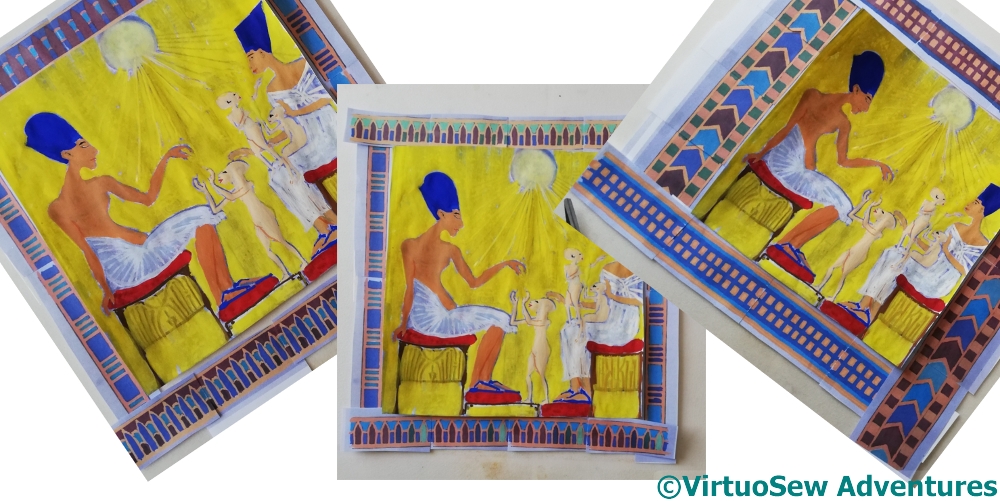
So, the one on the right – no, the borders are too wide, and given the size I’m going to do it, they’ll take away too much of the design area from the family group. I do like that arrowhead design, though. I wonder where else I could put it?
I started playing around with the widths of the borders a bit more (computers are very useful for scaling fiddly things like this – more new tricks learned!), and ended up with something I think will work. You can see that there are some details I’ve not quite settled yet, and indeed, I think I’ve decided to reverse the colours in the vertical borders. The blocky colours come from having used the computer to produce a line drawing, and then coloured it in by computer as well.
The design is now transferred onto the calico, and coloured in with inktense blocks. Rather sloppily, I know, but none of this will be visible, and I will be tweaking the design as I go, in any case. This is just to give me a a better chance to keep track of which colour I’m intending to use where – that small section with Nefertiti and the two little girls on her lap was dismally confusing before I painted it!
I have begun to stitch, and just as I promised (threatened?), I’ve been recording my progress, and uploaded the first video to: https://vimeo.com/402311907. It’s about twenty minutes long, spliced together from several files, because my camera kept switching off. I did say it would be a learning experience!
I hope it will be interesting, and maybe entertaining, for you all!
The Amarna Family Group
The eagle-eyed will have noticed that I now have a Ko-fi account. I’ve been meaning to do that for a while, but the current situation has given me plenty of time in which to do so. At the moment, the hope is that any “coffees” will help with the costs of running this blog, but in the next couple of years, I hope they could also help with venue costs to hold an exhibition of “Dreams of Amarna” embroidery.
I’m going to try to learn a few new tricks while we all need to keep safe at home, trying to slow the spread of the coronavirus, and one of them relates to this project. It occurred to me that people may need something gentle to watch, so I’m going to try to work out how to do little videos of the stitching. So, health permitting, watch this space…!
I had thought that once I’d done the Faience Necklace, and finished the Hunting Cat Fresco, that would be all for Dreams of Amarna, but then it occurred to me that the informality and intimacy of the depictions of the Royal Family in Amarna-period art was one of the reasons it has caught and held our attention. Mary Chubb describes the scene depicted on this stele in her book (there are several broadly similar scenes), and it came to my mind in conjunction with the bejewelled golden chair in Tutankhamun’s tomb which shows him with his wife in a similarly informal pose.
So I’m going to work it in or nué. I’ve been playing with my paints and some prints of the stele, trying to find a satisfying arrangement of colours, and work out what I’m not going to include – for instance, the hieroglyphs, at least half the rays of the Aten sun disc, and the gold torques in Akhenaten’s lap. I’m struggling a little with colourings, because the grey background of the print rewards the use of yellow (/gold) whereas on the background of gold used for or nué that colour becomes insignificant.
Then I need to plan a border for it….
Progress on the Faience Necklace
I love flat silk. The colours fairly glow, and it gives you endless options for creating threads of different thicknesses and twist levels. I’m hoping to use at least some of those possibilities in this project, to represent the gloss effect of the brightly coloured faience broad collars that inspired it.
I’m sure I’m missing some of the possibilities, but the mere fact that I’m excited and intrigued by what I’ve already thought of tells me that my holiday with the Three Wise Hounds was the right thing to have been doing.
The first thing I have to do is to pad all the elements. I’ve padded them using stranded cotton, which has a bit more body than the silk. I don’t have quite the right colours, but trust me, that’s not going to matter, as the padding won’t be seen.
There are at least two layers of padding almost everywhere (only one for the lilac tips of the backmost petals of the open lotus flower), and most of them have four. The padding stitches of each layer are at an angle relative to the previous layer, which stops them sinking into one another.
The basis of each element is going to be satin stitch in flat silk. The flat silk spreads beautifully over the cotton padding, so that at least will be pleasing to see.
I’ve set my frame up properly this time, with the fabric you will see supported by calico, and the combination is strong and taut enough to bear the weight of my little magnetic needle keeper. It’s the first time I’ve been able to use one, and it’s turning out very useful indeed. I’ve had it for a couple of years, and now I am wondering what took me so long.
Mounting Akhenaten – Part Two
Now, if your memory reaches back to the beginning of Akhenaten (no surprise if it doesn’t – that was in 2017!), you may recall that at the very beginning there were four layers – the calico, polyester wadding, light cotton padding, and then the silk. The first stage was then to outline Akhenaten and cut away all of the light polyester padding that wasn’t behind him.
So once the calico was laced into place, the next layer to be dealt with was the cotton padding. The eagle eyed may have noted that there’s a new piece of card here. That’s because this card has slots in to carry cotton tape. I’m intending to lace the finished panel to the middle of a larger fabric covered panel, and these tapes will help to support the weight. I hope. This is not a method of mounting I’ve ever seen before, and I’m making it up as I go along!
Then I pinned the silk into place, carefully, and not too tightly. Once I’d finished that, I turned over the whole thing and breathed a sigh of relief – the uraeus is still undamaged!
Then I wrapped him in acid-free tissue paper and put him away in a box. There are two reasons for this – firstly, because fibres and fabrics, particularly delicate ones, don’t like prolonged manipulation (yes, honestly, fibre in spinning mills is often left to “relax” between processes!), and secondly, because I’m still thinking about the details of the next stage.
The next stage is to fix the silk in place, and I’m still trying to work out how to do that without tangling with the cotton tape. I may decide to use double-sided sticky tape, but that is more likely to degrade and give way than lacing, and I really don’t want to do this job twice!
Finally starting the Faience Necklace
When, after my holiday with the Hounds, I came back to the Faience Necklace designs I’d created with my painted cutouts, I found that the version I’d liked then no longer appealed. Instead, it was the various spirals that sprang out at me, so I began to play with them a little more, tweaking and varying the design.
I must remember paper cutouts as a future designing method. It makes it much easier to play with a lot of variants in a relatively short space of time!
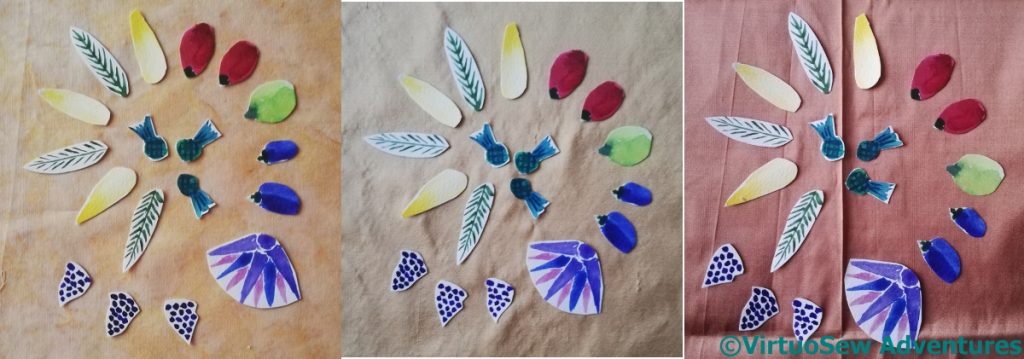
Then I had to decide on a fabric. No, I hadn’t ironed the silk on the right. This was very much an improvisation! From left to right – a quilting cotton I used in “Loading The Felucca“, a leftover of the silk I used for the “Head of Ankhsenpaaten“, and a silk in a shade very similar to that used for the “Colossus of Akhenaten“. In the end I decided that the sandy print on the cotton would help to evoke that sand in which they were digging, and framed up. I’ve put a calico backing in in the frame, and attached the cotton over the top.
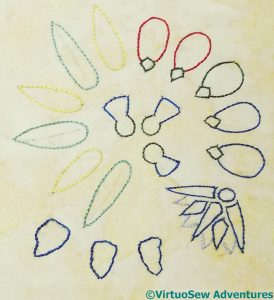
Since it’s winter, I’ve been working under my craft light, and it does rather wash out colours. I’m using Japanese flat silk (not sure why, it just seemed to be what I wanted to do), and I’ve started by hand-twisting some fine thread and outlining each element in reverse chain stitch.
This does two things – it covers the design transfer lines and it allows me to think about how I’m going to tackle it. Originally I was going to work each element in satin stitch, to echo the high gloss of the faience, but now I’m beginning to think more and more of using stitch to echo the natural elements the faience depicts. Remember what I said, when I finished the Hounds, about returning to my first love, the effects of stitch and thread?
Nefertiti Shawl – Green Panels finished
So here is the first of the green panels.
I’ve used stranded and floss silks, in variegated and plain colours.
The stitches are Woven Stitch, Bokhara Couching, Trellis Couching, Burden Stitch, and Darning Stitch, and wherever it’s possible to use two different threads in a stitch, I have done so, usually contrasting a plain with a variegated colour, or (sometimes and) a stranded with a floss silk.
Oh, I forgot – there was stitch orientation, too – vertical, horizontal, right-facing diagonal, left-facing diagonal!
Okaaaay. That made the “duality” idea a tad daunting, but not half so confusing as starting without any plan at all!
Anyway, the result is that the areas of high stitch density and high reflectance have been moved around a bit, and the details of the patterning have changed a bit, too.
I’m going to drape the panel somewhere I can see it for a couple of weeks, to be sure I’m happy with how it’s turned out, and then I’m going to line it with another pashmina. I’m planning to stitch in self-colour along all the gold lines, which will provide a slightly quilted look, and control the fabric a bit better, too.
Not to mention, making for a seriously cosy shawl!
Mounting Akhenaten – Part One
Akhenaten has been glaring at me autocratically (well, that’s in character, at least!) from the far side of the living room ever since I finished him, and I decided he needed to be off the frame and hidden away for a while. At the moment, I’m rather out of love with him, not even sure he’s come close to my original conception. I need to hide him away so that I can move on Other Things.
I took this photo just before I cut the thread holding the fabric in place, and you can see from the shadows just how strongly raised some elements are.
I think he’s looking pretty anxious about what lies ahead, as well!
I don’t think Akhenaten can possibly be as anxious as I am. We have a phrase in our house – “exporting stress”. There was a lot of that going on. In fact, I banished The Australian from the room lest I prove contagious!
However, I read, a little while ago, of using layers of bubble wrap to protect a raised piece while mounting, with holes or popped bubbles to alter the amount of padding so that the most highly-raised elements don’t also suffer the highest pressure. Considering the fragility of the uraeus, that’s important.
So I decided to give that a try. I’ll report when the whole process is finished!
And it’s going to be quite a process, because there are three layers of fabric to wrangle, and I’m not going to frame him under glass, so the mounting is going to be on display, at least to a degree.
I’ve started by lacing the long sides of the calico supporting layer, quite closely, to spread out the tension, and then the short sides. These were spread out a bit more, and I also stitched the edges of the folded-up short sections to the calico sides.
Nefertiti Shawl – an excursion into duality
Having completed one green panel, I decided that I wanted the other green panel to be not quite the same, and I couldn’t work out how to approach keeping the family resemblance and maintaining some sense of balance.
So I asked The Australian, who you may remember is also a mathematician. He looked at me in some perplexity for a while. In fact, as I explained the layers of patterns I’d created, he eyed me more than a little askance, and then went very quiet for a while (you’d think he’d be used to it by now…).
Finally, he suggested I think about duality. Now, this isn’t a philosphical thing – it’s quite tightly defined, in the geometrical sense, at least – see this Wikipedia page – so after some discussion over lunch, we decided that if I were to regard the elements of the two green panels as duals of one another, it would give me a systematic way to approach the second one, rather than flailing around randomly.
Now I had to decide what was what’s dual….
For example, in the first panel, I chose between floss silk or stranded silk, and in the case of stranded, between solid colour and variegated; then in terms of stitch orientation (going clockwise), between vertical, diagonal, horizontal and the other diagonal. In this context, I’m not sticking to the idea of a binary choice, so for example with stitch orientation I will go to the next 45degree angle around the clock face, while with the thread, I’m going to pick some ordering of variegated stranded, plain stranded and variegated floss and then move along to the next in that sequence.
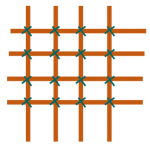
In terms of the stitch choice, essentially there are four: Jacobean trellis, darning stitch (rows of irregular running stitch, in effect), Bokhara couching, and Woven Stitch.
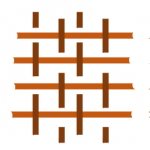
I can choose to make Bokhara Couching and darning stitch each other’s duals – that will move the heaviest stitching to different places in the panel.
The other two will be each other’s duals, with the added complication that they have each involved two different threads.
Have I simplified my life or complicated it?

